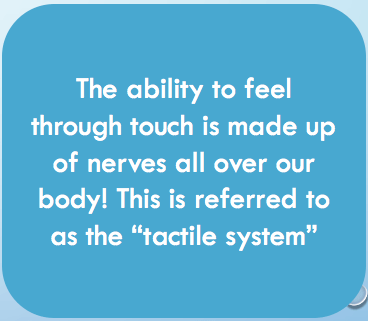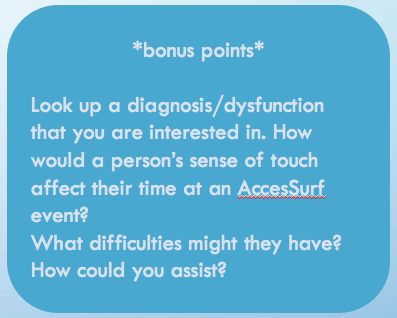Our tactile system allows us to understand:
- Pressure
- Temperature
- Texture
- The “feel” of something

Powers of the Tactile System
The tactile system allows us to:
- Pull your favorite toy out of a bin without looking
- Recognize when the ocean water is warm (and when it gets too cold!)
- Have a favorite shirt because of the way it feels on your skin
- Distinguish if a coral is smooth, rough, sharp, cool, hard, etc.
We use our tactile system throughout the day for many activities unknowingly!
Tactile System Dysfunction
In some cases, there are problems with the tactile system that make participating in day-to-day activities very difficult.
A person may be hypersensitive to touch or hyposensitive.
Hypersensitivity
Hypersensitivity is when the brain processes touch in an unusual way, making the tactile system perceive the feeling as unusual, unpleasant, or even painful (even though most people might find the feeling pleasant).
These unusual feelings can range from mild to severe
For those individuals, touch often makes them feel overwhelmed, and they will often avoid situations that cause them to touch things their body does not like.
This might look like:
- Staying on the grass because they do not like the texture of sand on their feet
- Avoiding dunking their head in the ocean because they don’t like the feeling of the water on their face
- Avoiding the shower to rinse off because they don’t like the pressure of the water
- Avoiding wearing a rash guard because the sensation is too tight
- Avoiding hugging, high fives, and back pats because these are unexpected touches
What can I do?
For hypersensitivity, it is important to respect and recognize the person’s sensations. No one wants to do something that feels unpleasant or painful.
Work around it (get creative!)
- Is there a way to get to the beach without touching the sand?
Using a beach chair, piggy backing, walking on the mats, etc.
- Is there a way to rinse off without standing directly under the shower?
Filling a large bucket to dunk feet in, dumping bucket over head, using a wet washcloth, etc.
Make it easier
- Is it possible to break it down to make the task easier/more manageable?
Try getting in the water up to their waist, move up to their shoulders, blow bubbles in the water with their mouth or with their nose? Can they dunk their head with goggles and plugging their nose?
Hyposensitivity
The brain and body may crave more sensation and may seek out more opportunities to touch and feel certain things to give the body what it needs.
These actions may range from mild to severe.
Some need this extra sensation in order to pay attention (think of fiddling with your pencil in class to pay attention, or listening to music in order to focus on a task).
This might look like:
- Fiddling with objects
- Sitting very close to others
- Consistently hugging, high-fiving, or bumping into other individuals
- Squeezing, touching, grabbing items (even dangerous ones like wana/sea urchins)
What can I do?
For hyposensitivity, we can try to fulfill their sensory craving if it looks like it helps them to focus and participate.
Substitute
- If you notice someone constantly hugging others, can you provide them something else that will give them that deep pressure sensation?
Try burying each other in the sand, doing cannon balls into the waves, laying on and practicing pushing up on the surf board.
- If you see someone playing with potentially dangerous objects (hitting sticks together, throwing coral, reaching for wana)
Trying substituting for a beach ball to hit, throwing sand balls in the ocean, touching grass or flowers.
Common Diagnoses with Tactile Dysfunction
- Autism Spectrum Disorder
- Sensory Processing Disorder
- Diabetes
- Guillain-Barre Syndrome
- Nerve injury/damage


